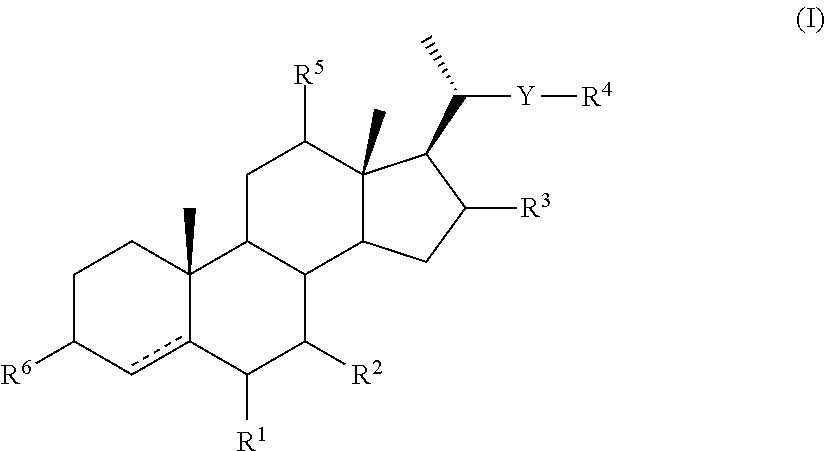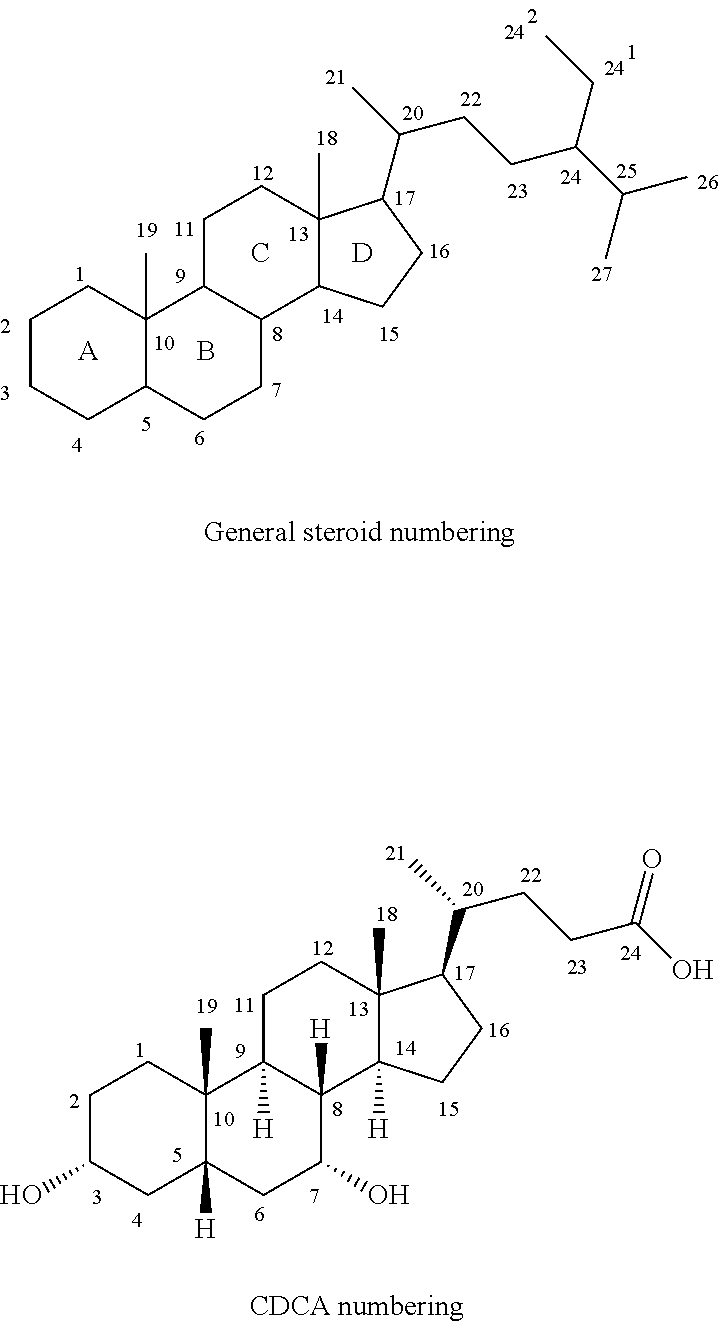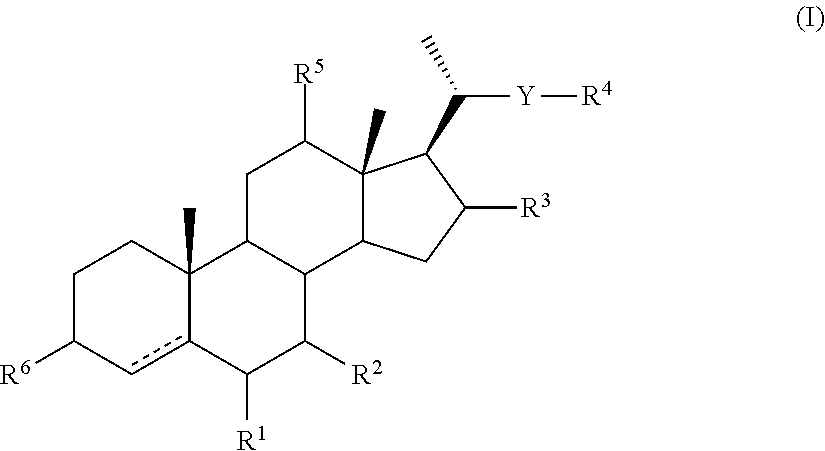Intermediates for the Synthesis of Bile Acid Derivatives, in Particular of Obeticholic Acid
a technology of obeticholic acid and intermediates, which is applied in the direction of steroids, organic chemistry, chemistry apparatus and processes, etc., can solve the problems of low overall yield, 12 steps, and low availability of starting materials, and achieves limited availability of cholic acid and other bile acids
- Summary
- Abstract
- Description
- Claims
- Application Information
AI Technical Summary
Benefits of technology
Problems solved by technology
Method used
Image
Examples
example 2
on of Compounds of General Formula (IA)
A. Epoxidation of (22E)-3-oxo-4,6,22-cholatrien-24-oic Acid Ethyl Ester Using Methyltrioxorhenium to Form (6α, 7α, 22E)-6,7-epoxy-3-oxo-4,22-choladien-24-oic Acid Ethyl Ester
[0317]
[0318]To a solution of (22E)-3-oxo-4,6,22-cholatrien-24-oic acid ethyl ester (5.00 g, 12.6 mmol) in HFIP (20 mL, 4 volumes) and EtOAc (10 mL, 2 volumes) was added MTO (37 mg, 0.126 mmol) and 3-methylpyrazole (122 μl, 1.51 mmol) and the mixture was cooled to 5° C. UHP (1.30 g, 13.9 mmol) was added portion-wise and the mixture was stirred at 5° C. for 24 h. After 24 h, a second addition of MTO (37 mg, 0.126 mmol) and UHP (1.30 g, 13.9 mmol) was conducted and the reaction was stirred at 5° C. for 18 h. The reaction was then quenched by the portion-wise addition of 12% aq. NaHSO3 (15 mL) maintaining the temperature 3 (20 mL), water (20 mL) and then concentrated under reduced pressure. The crude material (5.72 g) was crystallised from EtOAc (15 mL).
Further Epoxidation Reac...
example 3
on of Compounds of General Formula (XXI) Via Compounds of General Formula (I) with Malonate Side Chain
[0346]The compounds of general formula (II) may be converted to compounds of general formula (IA) as described above and these compounds may then be converted to compounds of general formula (IB), (IC), (ID), (IE) and (IF) by the methods described below. A compound of general formula (IF) may be converted to a compound of general (XXI).
[0347]The following illustrates the conversion of a compound of general formula (II) in which —YR4 is CH2OH via compounds of formulae (IA), (IB), (IC), (ID) and (IE) in which —YR4 is —CH2CH[C(O)OMe]2 to a compound of general formula (XXI) in which R4a is C(O)OH is shown in Scheme 4 below.
A. Synthesis of 23-carboxy-3-oxo-4-cholen-24-oic Acid Dimethyl Ester
[0348]
[0349]To a suspension of (20S)-20-bromomethyl-4-pregnen-3-one (15 g, 38.1 mmol), tetrabutylammonium bromide (1.2 g, 3.8 mmol) and potassium carbonate (26.3 g, 191 mmol) in toluene (150 mL) was a...
example 4
on of an Analogue of a Compound of General Formula (I) and a Compound of General Formula (XXI) Via Compounds of General Formula (I) with Nitrile Side Chain (Including Side Chain Extension)
[0388]Scheme 5 shows the conversion of a compound of general formula (II) in which —YR4 is CH2OH conversion to a compound of general formula (II) in which —YR4 is —CH2CH2—CN and subsequently to a compound of general formula (XXI) in which —YR4a is CH2CH2C(O)OH. The reaction proceeds via compounds of general formulae (IA), (IB), (IC) and (IE) in which —YR4 is —CH2CH2—CN. The compound of general formula (IE) is then converted to a 3-OH analogue and the side chain is then converted to —CH2CH2—C(O)OH.
A. Synthesis of (20S)-20-bromomethyl-3,3-ethylenedioxy-4-pregnene and (20S)-20-bromomethyl-3,3-ethylenedioxy-5-pregnene
[0389]
[0390]To a solution of (20S)-20-bromomethyl-4-pregnen-3-one (1.00 g, 2.59 mmol) and ethylene glycol (2.0 mL, 36.25 mmol) in toluene (30 mL) was added pTSA.H2O (9.86 mg, 0.05 mmol) an...
PUM
| Property | Measurement | Unit |
|---|---|---|
| temperature | aaaaa | aaaaa |
| temperature | aaaaa | aaaaa |
| temperature | aaaaa | aaaaa |
Abstract
Description
Claims
Application Information
 Login to View More
Login to View More - R&D
- Intellectual Property
- Life Sciences
- Materials
- Tech Scout
- Unparalleled Data Quality
- Higher Quality Content
- 60% Fewer Hallucinations
Browse by: Latest US Patents, China's latest patents, Technical Efficacy Thesaurus, Application Domain, Technology Topic, Popular Technical Reports.
© 2025 PatSnap. All rights reserved.Legal|Privacy policy|Modern Slavery Act Transparency Statement|Sitemap|About US| Contact US: help@patsnap.com



